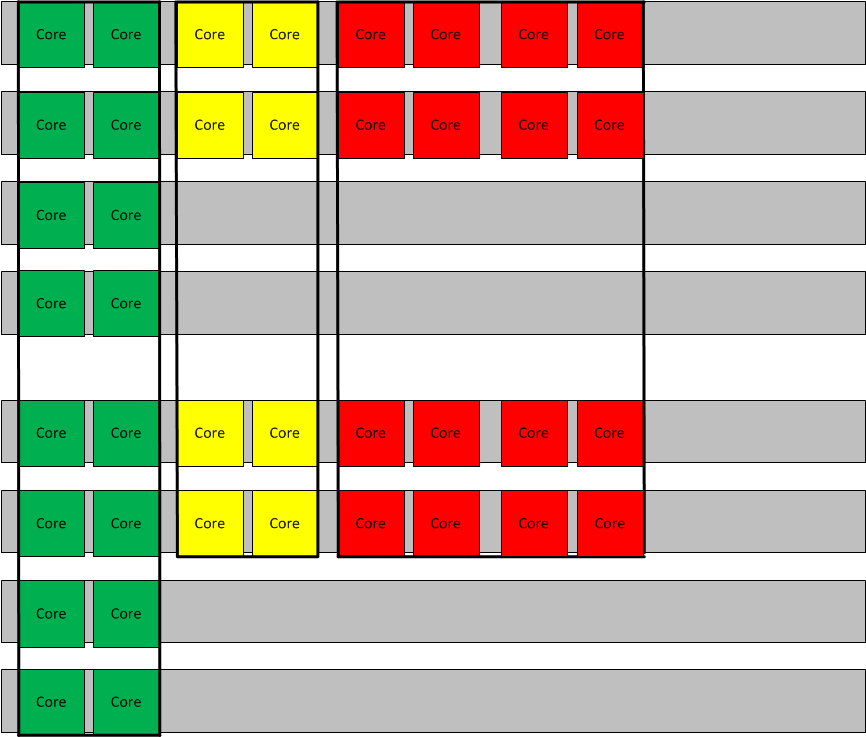Applies To:
Show Versions
BIG-IP AAM
- 11.6.5, 11.6.4, 11.6.3, 11.6.2, 11.6.1
BIG-IP APM
- 11.6.5, 11.6.4, 11.6.3, 11.6.2, 11.6.1
BIG-IP GTM
- 11.6.5, 11.6.4, 11.6.3, 11.6.2, 11.6.1
BIG-IP LTM
- 11.6.5, 11.6.4, 11.6.3, 11.6.2, 11.6.1
BIG-IP ASM
- 11.6.5, 11.6.4, 11.6.3, 11.6.2, 11.6.1
Overview: Device service clustering for vCMP systems
One of the tasks of a vCMP guest administrator is to configure device service clustering (DSC). Using DSC, a guest administrator can implement config sync, failover, and mirroring across two or more chassis. Configuring DSC is the same on a vCMP system as on non-virtualized systems, except that the members of a device group are virtual devices (guests) rather than physical devices.
When configuring DSC, a guest administrator creates a device group that consists of vCMP guests as members, where each member is deployed on a separate chassis.
For example, a Sync-Failover device group in an active-standby configuration can consist of:
- guest_A on chassis_1 and guest_A on chassis_2
- guest_B on chassis_1 and guest_B on chassis_2
- guest_C on chassis_1 and guest_C on chassis_2
Creating a device group that consists of guests on separate chassis ensures that if a chassis goes out of service, any active traffic groups on a guest can fail over to a device group member on another chassis.
This illustration shows this DSC configuration. The illustration shows two four-slot chassis, with three guests on each chassis. Each guest and its equivalent guest on the other chassis form a separate Sync-Failover device group.
 vCMP guests forming three device groups across two chassis
vCMP guests forming three device groups across two chassis
Required IP addresses for DSC configuration
This table describes the types of IP addresses that a guest administrator specifies when configuring device service clustering (DSC) on a vCMP system.
| Configuration feature | IP addresses required |
|---|---|
| Device trust | The cluster IP address that the vCMP host administrator assigned to the guest during guest creation. |
| Config sync | Any non-floating self IP address on the guest that is associated with an internal VLAN on the host. |
| Failover |
|
| Connection mirroring | For both the primary and the secondary IP addresses, a non-floating self IP address on the guest that is associated with an internal VLAN on the host. The secondary address is optional. |
Failover methods for vCMP guests
Each traffic group in a device service clustering (DSC) device group has a property known as a failover method. The failover method dictates the way that the system chooses a target device for failover. Available failover methods that the user can choose from are: load-aware failover, an ordered list, and an HA group.
The specific core allocation and slot assignments for a guest in a Sync-Failover device group determine the particular failover method that is appropriate for a DSC traffic group within the guest:
- Guests in a device group that are identical in terms of core allocation and slot assignment are considered to be homogeneous guests. In this case, an ordered list would be an appropriate failover method, since relative capacity is equal among all guests.
- Guests in a device group that differ from one another in terms of core allocation and slot assignments are considered to be heterogeneous guests. In this case, load-aware failover is an appropriate failover method because the guest administrator can define a relative capacity and relative traffic load for each guest. For example, an eight-core, four-slot guest has a relative capacity that is twice that of a four-core, two-slot guest.
An additional type of failover method is an HA group, which applies to both homogeneous and heterogeneous guests.
About HA groups for vCMP systems
For failover configuration, an alternative to using load-aware failover or an ordered list is to use HA groups. An HA group is a set of trunks, pools, or clusters (or any combination of these) that a guest administrator creates and associates with a traffic group. The most common reason to use HA groups is to ensure that failover is triggered when some number of trunk members become unavailable.
The BIG-IP system uses an HA group to calculate an overall health score for a guest. The guest that has the best overall score at any given time becomes or remains the active guest. With an HA group, the system triggers failover of a traffic group based on changes to trunk, pool, or cluster health instead of on system, gateway, or VLAN failure.
Because trunks are never synchronized between guests, the number of trunk members associated with an HA group often differs between guests on separate devices whenever a trunk loses or gains members.
About connection mirroring for vCMP systems
Connection mirroring is a device service clustering (DSC) feature that allows a device to mirror its connection and persistence information to another device. Connection mirroring prevents interruption in service during failover. On a vCMP system, the devices that mirror their connections to each other are virtual devices (vCMP guests).
Within any Sync-Failover device group on a vCMP system, connection mirroring can only be implemented between exactly two guests, and the two guests must reside on separate chassis and be homogeneous. The term homogeneous normally refers to platforms that are the same model of hardware, but in the context of vCMP, the term refers to guests that are equivalent in terms of resource allocation; that is, the guests are deployed on the same number of slots with the same number of cores allocated to them.





